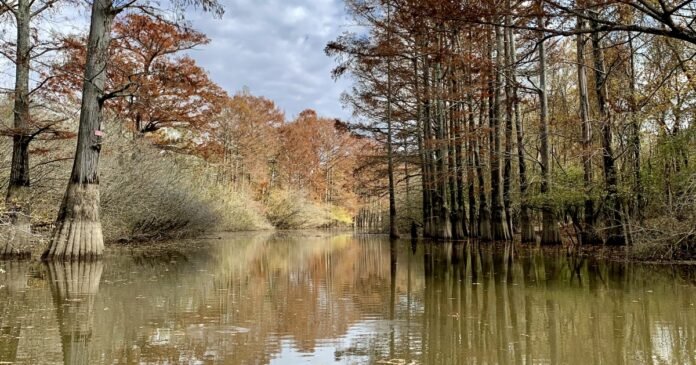Flooding is a recurring challenge for many communities, especially those located near rivers. In Patterson, Arkansas, the Cache River frequently becomes a central focus during flood events. This article will delve into the factors contributing to the flooding along the Cache River at Patterson, its impacts, and the measures residents and officials take to manage these situations. By understanding these elements, we can appreciate the efforts required to mitigate the effects of such natural events and the resilience of the people living in these flood-prone areas.
Causes of Flooding along the Cache River at Patterson
The Cache River at Patterson is a significant waterway in Arkansas that feeds into the White River, which eventually connects to the Mississippi River. When heavy rainfall occurs upstream, the water levels in the Cache River at Patterson can rise dramatically. This rise is often compounded when the White River is already high, as it can cause the Cache River at Patterson to back up, leading to severe flooding in Patterson and surrounding areas.
One of the primary factors contributing to flooding along the Cache River at Patterson is the geography of the region. Patterson is situated in a low-lying area, which makes it particularly susceptible to floodwaters. Additionally, the surrounding land is often saturated from previous rains, which means that any new rainfall contributes to an increased risk of flooding. When the White River is also high, it acts as a barrier, causing the Cache River at Patterson to hold water longer and exacerbate the flooding situation.
Impact on Local Infrastructure and Residents
The impact of flooding along the Cache River at Patterson is felt across various aspects of daily life. One of the most immediate effects is on local infrastructure. Roads in the area can become submerged, making travel difficult or impossible. In some cases, newly installed culverts designed to manage water flow can be overwhelmed by the sheer volume of water, leading to further complications.
Residents of Patterson, like Emmett Garner who has lived along the Cache River at Patterson for over four decades, face significant challenges due to frequent flooding. Garner has invested in building a re-lift pump and retaining wall to protect his property. He has also raised his land with gravel and dirt to prevent water damage. Despite these efforts, flooding remains a persistent issue, requiring constant vigilance and preparedness.
Agricultural Concerns
Agriculture is another area significantly impacted by flooding along the Cache River at Patterson. Farmers in Patterson are often faced with the challenge of protecting their crops from floodwaters. When the river crests and floods farmland, it can destroy crops and delay planting. The consequences for local agriculture can be severe, affecting not just the immediate yield but also the long-term viability of farming in the region.
Charles Dallas, the Woodruff County Judge, notes that when the Cache River at Patterson floods, it can lead to substantial water coverage over farmland. This situation complicates efforts to plant and harvest crops, with potential losses that can ripple through the local economy. When flooding is particularly severe, it can take days or even weeks for the water levels to recede, during which time farmers are unable to access their fields.

Flood Management Strategies
To manage and mitigate the effects of flooding, various strategies are employed by both local authorities and residents. One common approach is the construction of levees and flood barriers. These structures are designed to redirect or contain floodwaters, preventing them from inundating residential and agricultural areas. For example, Garner’s property has been protected with a levee system and a re-lift pump to manage the water levels effectively.
Another key strategy is the installation of culverts and drainage systems. These are intended to help manage the flow of water and prevent it from accumulating in undesired areas. However, as noted, these systems can sometimes be overwhelmed by the volume of water, especially during extreme flooding events.
Community preparedness is also crucial. Residents like Garner are well-versed in the patterns of flooding and take proactive steps to safeguard their properties. This includes moving valuable items to higher ground, reinforcing flood barriers, and staying informed about weather conditions and flood warnings.
Conclusion
Flooding along the Cache River at Patterson presents significant challenges for both residents and local infrastructure. The combination of geographical factors, upstream water levels, and heavy rainfall contributes to the severity and frequency of floods in the region. The impact on local roads, agriculture, and daily life underscores the importance of effective flood management strategies.
Efforts to mitigate flooding include building levees, installing drainage systems, and preparing communities for potential flood events. Despite these measures, flooding remains a recurring issue that requires ongoing attention and adaptation. Understanding the dynamics of flooding along the Cache River at Patterson helps us appreciate the resilience of the Patterson community and the importance of continued investment in flood management and preparedness.
FAQs about Flooding along the Cache River at Patterson
Q: What causes flooding along the Cache River at Patterson?
A: Flooding occurs due to heavy rainfall upstream, which increases water levels in the Cache River. If the White River is also high, it can cause the Cache River to back up, leading to severe flooding in Patterson.
Q: How does the geography of Patterson affect flooding?
A: Patterson is located in a low-lying area, making it particularly vulnerable to floodwaters. The region’s land is often saturated from previous rains, which exacerbates the flooding risk with any new rainfall.
Q: What are some impacts of flooding on local infrastructure?
A: Flooding can submerge roads, making travel difficult or impossible. Additionally, newly installed culverts and drainage systems may be overwhelmed by the high volume of water, leading to further complications.
Q: How does flooding affect local agriculture?
A: Flooding can destroy crops, delay planting, and create significant challenges for farmers. The coverage of farmland by floodwaters can impact both immediate yields and the long-term viability of farming in the region.
Q: What measures are taken to manage flooding?
A: To manage flooding, levees and flood barriers are constructed to redirect or contain water. Culverts and drainage systems help manage water flow, and residents take proactive steps like reinforcing flood barriers and moving valuables to higher ground.

